Deer Facts
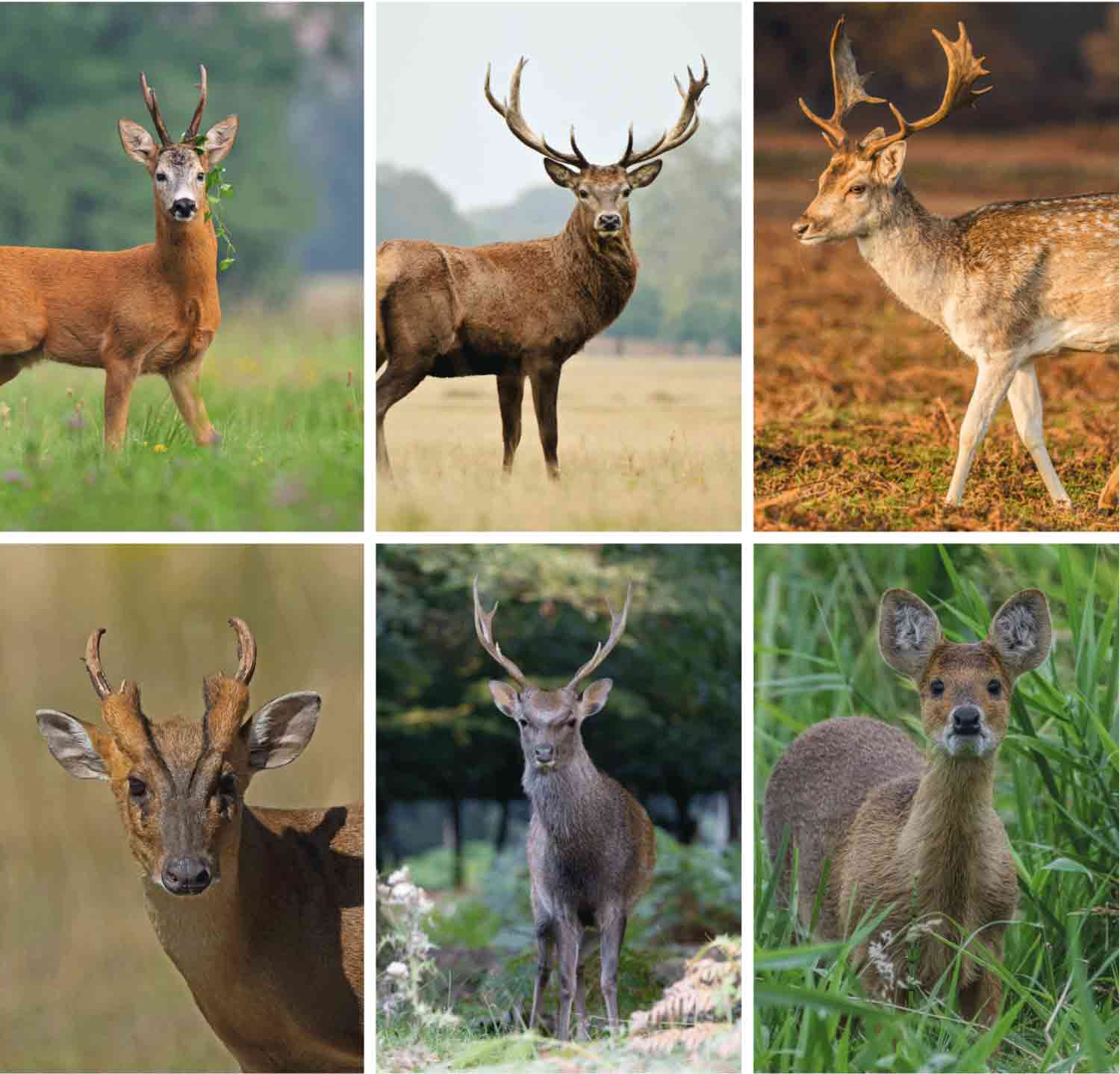
Species
There are 6 species of deer in the UK, which include the Red deer, Roe deer, Fallow deer, Sika deer, Muntjac dee and Chinese water deer. Only the roe deer and red deer are indigenous.
Scientific Names:
Red deer: Cervus elaphus
Roe deer: Capreolus capreolus
Fallow deer: Dama dama
Sika deer: Cervus nippon
Reeves’ muntjac deer: Muntiacus reevesi
Chinese water deer: Hydropotes inermis
Facts
Size:The red deer is the largest deer in the UK, reaching up to 140cm at the shoulder and weighing 190kg. At the other end of the scale, the muntjac deer is the smallest in the UK, reaching just 45cm at the shoulder and weighing about 13kg.
Diet: Herbivorous- grasses, sedges, the leaves and shoots of trees and other woody plants. Fruit and berries are sometimes eaten, too, while treebarki s takenwhenotherfoodi sscarce.
Average Lifespan: The life expectancy of a deer in the wild does vary. The muntjac, red deer, sika deer, and fallow deer can live more than 15years. Whilst the Chinese water deer and the roe deer will live between 5-8 years.
When to see them: All year round.
UK conservation status: Common and widespread
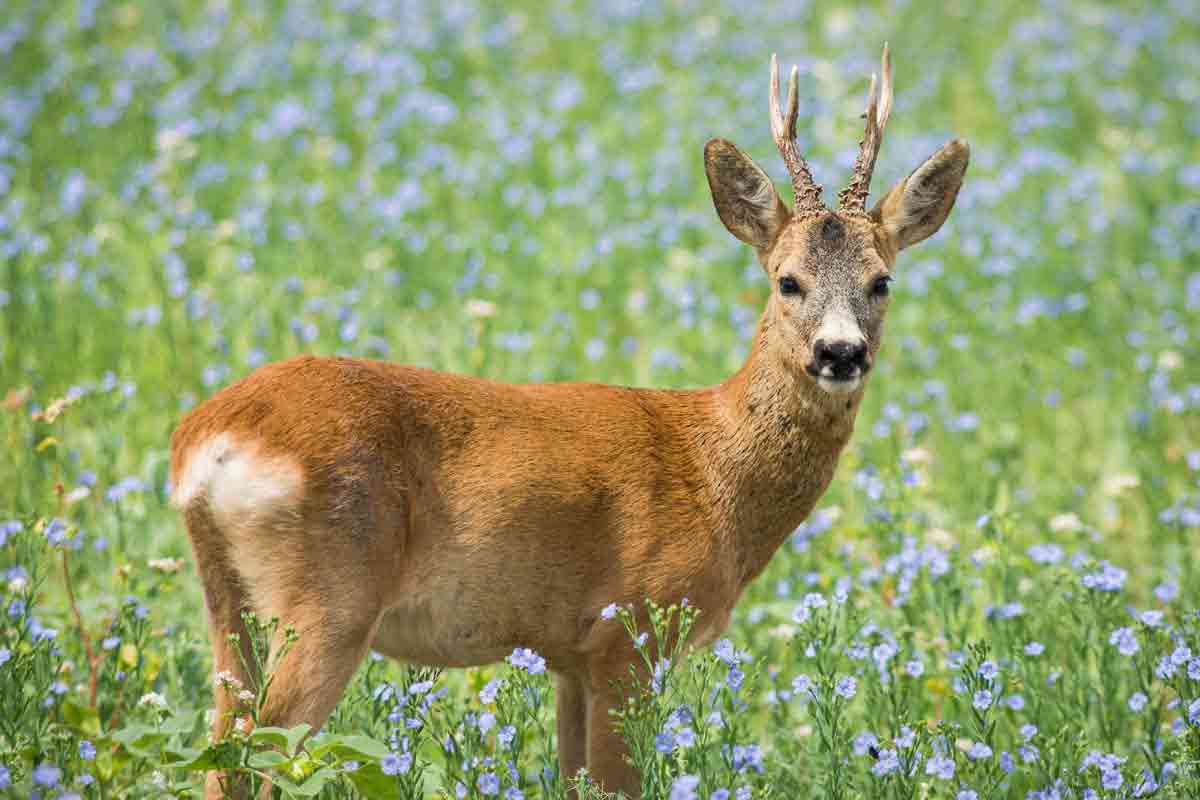
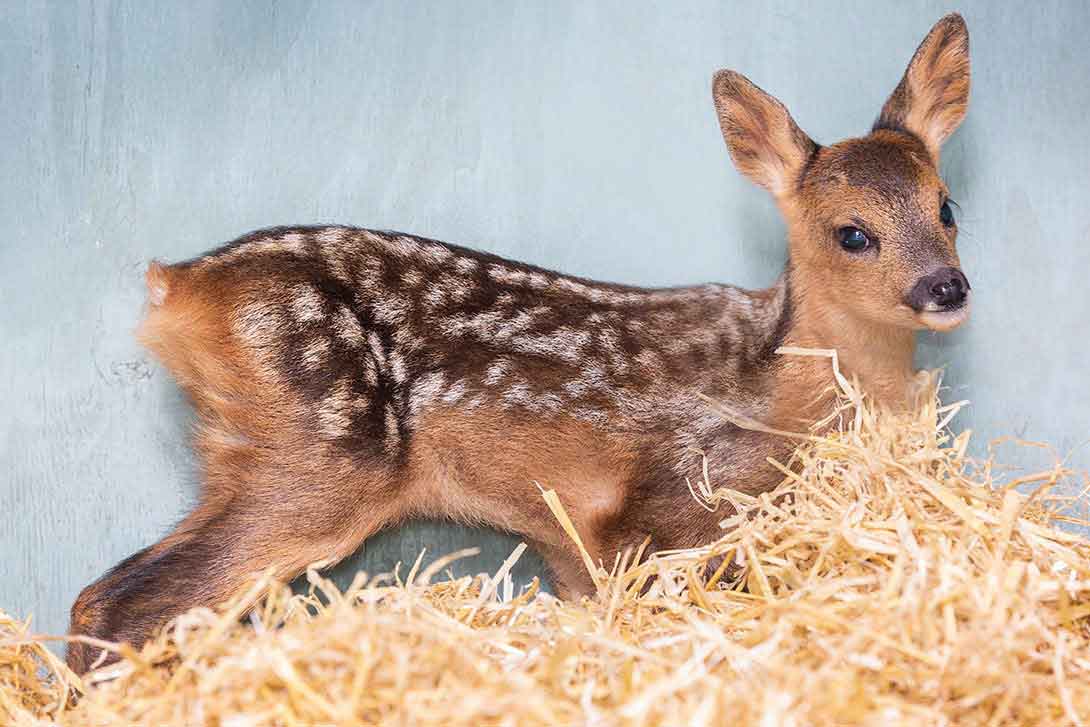
Behaviour
Deer will mostly move around early morning or late evening in search for food and grazing. They are elusive animals and, as prey species, they can be hyper-aware of noises, smells, and movements around them. The red and fallow deer are the only two species of deer that form large herds, which can consist of more than 40 individuals. The remaining four species-muntjac, roe, water and sika- may form small herds, but predominantly muntjac, roe and water deer are solitary outside of the mating season.
Breeding: Mating season, for most deer species, occurs around autumn, the exception being roe and muntjac deer, for which the former begins mating in mid-summer, whilst the latter has no defined mating season, with fawns being born throughout the year. Fawning, for all species, except for the muntjac, occurs around May to July.
Their Threats
Man-made objects: One of the biggest threats to wild deer is man-made objects, such as netting and fencing. Quite often, wild deer will become entangled in these objects and, on occasion, be unable to release themselves.
RTA (Road Traffic Accidents): More than 200 deer are hit by cars, every day, in the UK. As more roads are built and natural deer habitat becomes fragmented, this number will, sadly, only increase.
This is not sustainable for wild populations, and we must do more to protect wild deer. You can help make changes to current policies surrounding infrastructure and increasing considerations for deer and other wildlife by reporting road traffic accidents of deer to The Road Lab, a citizen science-based project helping to identify problem areas for wildlife.
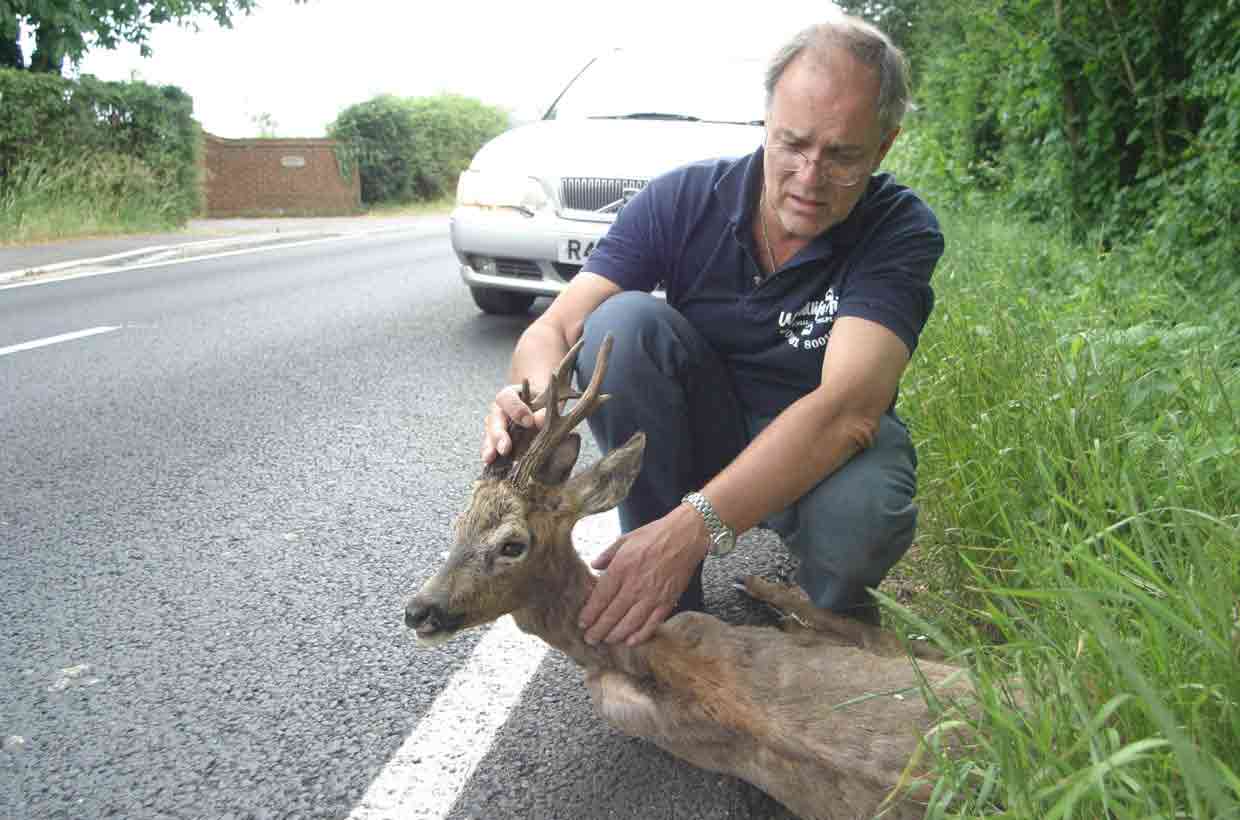
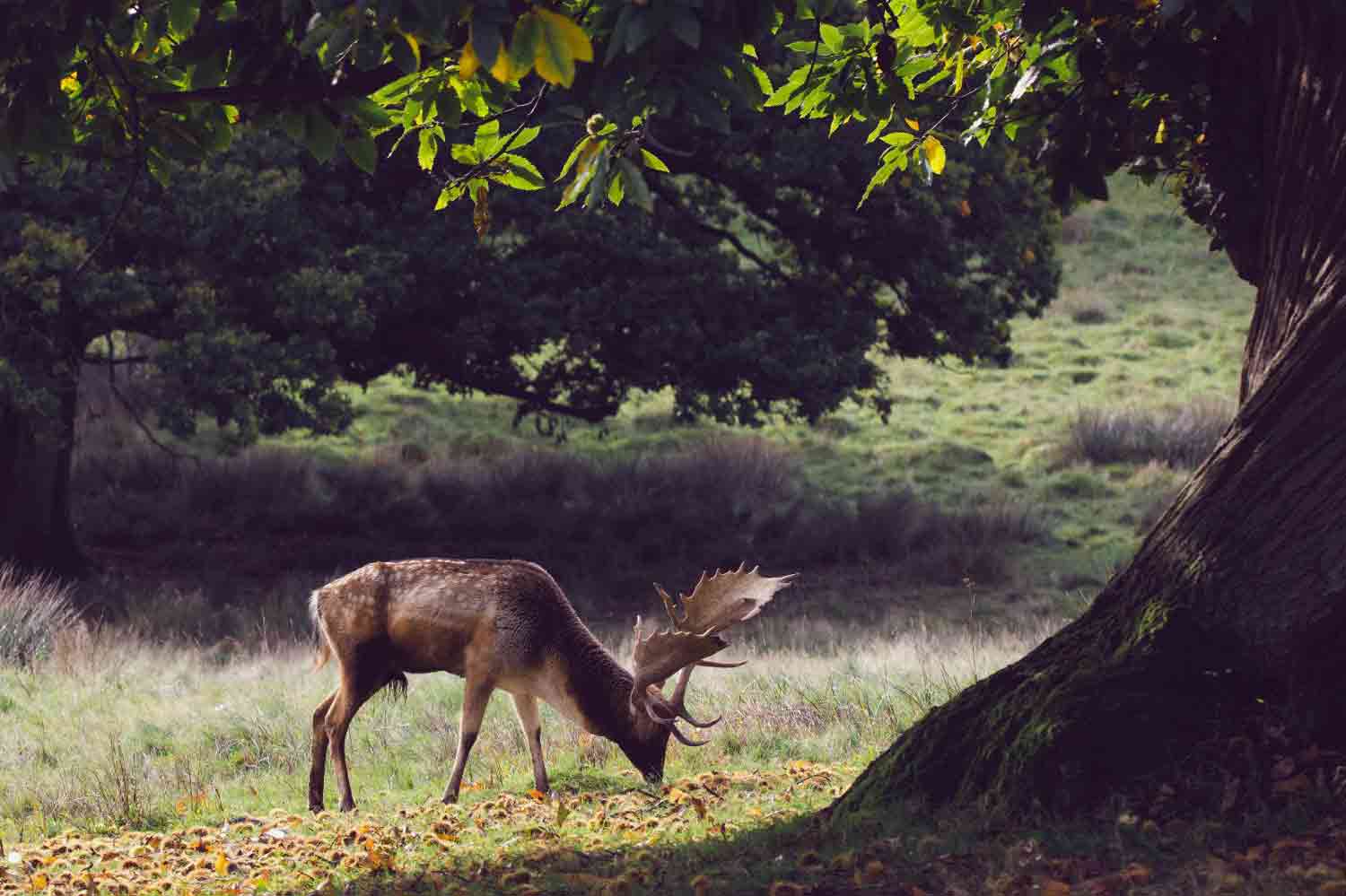
How you can help
There are a number of simple ways you can help deer.
- Plant fruit trees and shrubs early to provide a food source.
- Re-wild areas of your garden and use hedges to create corridors within their habitat.
- Slow down on roads, especially around dusk and dawn.
- Keep a note for a local wildlife rescue in case you find an injured or orphaned deer.
Frequently Asked Deer Questions
I've found an injured deer, what do I do?
If found in the road and the deer is causing a hazard, please, put your hazard lights on to protect both you and the deer. NEVER try to pick up an injured deer without expert help. The main aim is to try to keep the animal calm until help arrives. Stand well back, keeping well away from the deer’s antlers and hooves, both of which can inflict a very serious injury.
Please, call the Wildlife Aid Foundation and we will send help, as soon as possible, if we are available. Otherwise, please, call the RSPCA if we cannot respond. NEVER transport a deer in your car! This will result in serious injury to the deer, you and your passengers.
Handling or sitting near deer causes incredible stress to them. This will bring on a condition called “Capture Myopathy”. Once this condition sets in, the deer will die.
Deer hit by cars may often be stunned and not injured. They can take up to an hour to rest and recover, and will then run off after this recovery period. Deer, in these instances, should be moved off the road and monitored. They will not need medical treatment unless they are actually injured. Many deer are brought in to rescue centres, unnecessarily, and when this happens it puts unnecessary stress on the animal and prevents recovery.
If the deer is injured, we may need to assess the chances of quick treatment and release, and to do this we will need to come and see the deer in situ. Broken limbs, in deer, are almost impossible to manage and, in these cases, it is usually kinder to humanely euthanise the patient, than attempt heroic surgery on an animal that does not tolerate captivity.
I have seen an adult deer with an injured leg
Unfortunately, if it is at all mobile, we will not be able to catch it. The best thing to do is carry out the ‘broom test’ to establish mobility. (Gently touch the animal with a broom handle to see if it responds – it will either flee or remain where it is.) A mobile deer, even on 3 legs, can still run faster and further than a rescuer. Keep it under observation, if possible, and call us again if it collapses.
There is an adult deer in my garden, and it cannot get out
It’s probably very unlikely – if it got in, it can almost certainly get out again. A deer can easily jump a 2-metre fence and will usually find its way out when it gets bored. Often, deer choose back gardens and secluded spots to rest up during the day, and will usually move away under the cover of darkness. Do not approach it, as it will cause it stress. Leave the deer until the next morning, and you’ll probably find it’s moved on.
Muntjac Deer
Muntjac are on the invasive species list and rescue centres are not permitted to release them. This does not include situations in which they are trapped in fences, etc.
Important!
Muntjac have small antlers, which end in a sharp point, and elongated canine teeth (tusks), which are dangerous. Both will cause serious injury; please, do not try to catch them, yourself!
Breeding & Fawns
Mothers will leave fawns for long periods of time; the mother will feed the fawn in the early morning (dawn), then go off to find food during the day, returning, periodically, to check on the fawn. The mother will not come back if there are people close to the baby, so don’t stay close, observe from a distance. The mother will come back to feed the fawn again.
If there is a fawn that is in distress or in an unsafe environment (out in the open, on or near to the road, or is really wet and cold and in an unsheltered area), please, ring us to come and assess the situation; do not move the fawn or disturb it. Please, wait nearby, so you can see the fawn, but not so close as to spook the mother, in case she is close by; she will not come out if she can see or scent the presence of people. Only ever interfere if the fawn is in immediate danger (in the road and may be hit by a car, has been attacked or likely to be attacked by a dog or other animal).
I have found a fawn lying in undergrowth, with no sign of an adult deer
Do not touch the fawn! If the fawn is lying down, but with its head up and eyes bright and alert, it has almost certainly just been left by its mother while she moves away to feed.
It should not be disturbed or picked up unless in imminent danger from dogs or machinery. Do not stroke it or touch it in any way, as human scent can cause its mother to abandon it. Watch the fawn from a distance, preferably by using binoculars, to see if the mother returns. Young deer are often left alone for several hours at a time, so you can check it again, later. If the mother does not return by dusk, call the Wildlife Aid Foundation for help and advice. A volunteer will probably need to attend the scene and assess the situation.
I have found a fawn, and it is injured/cold/crying
Do not touch the fawn! Observe the fawn for a couple of hours in case the mother is close by. However, if the mother does not return, then it’s possible she may have been killed or abandoned the fawn.
If the fawn is injured, then it may need to come in for treatment; we would send someone out to assess the injuries, before we brought it in. Never bring a fawn in yourself; always wait nearby until one of our rescuers arrives.
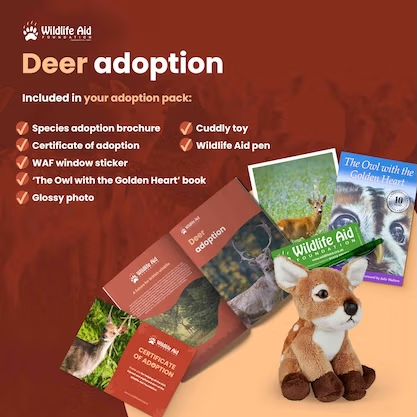
What’s included in your deer adoption pack
Not only will you be providing invaluable care and helping countless animals, but you will also receive an exclusive deer adoption pack, including cuddly toy, species brochure, certificate of adoption, photo and more. NOTE: The pack will include either ‘The Owl with the Golden Heart’ book or ‘Wildlife SOS’ book, dependent on stock.